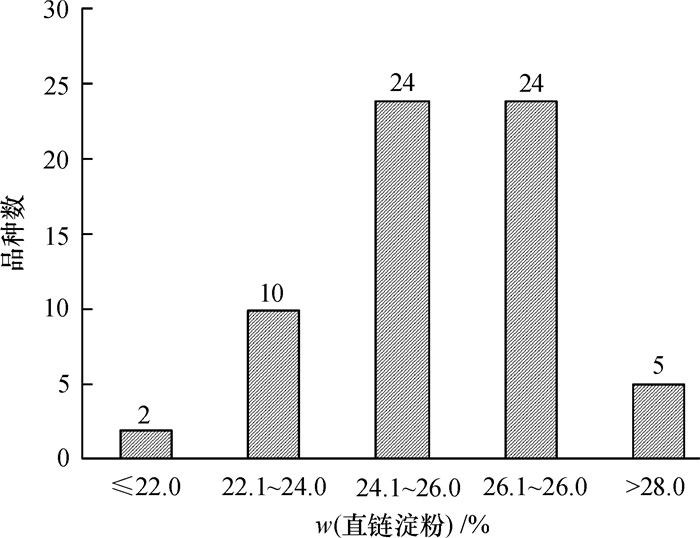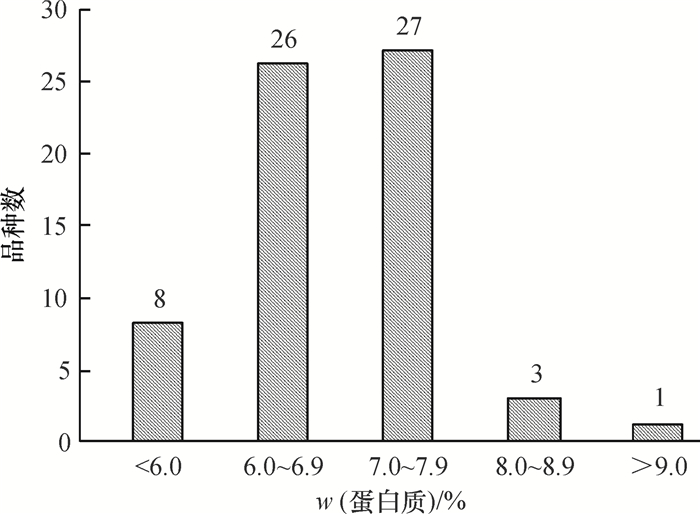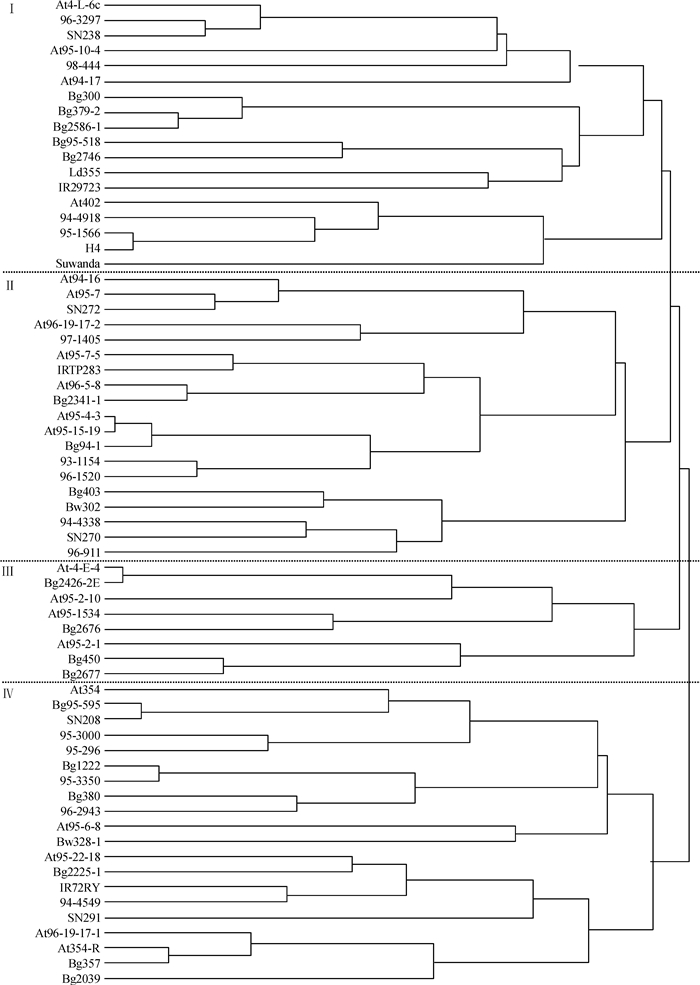Evaluations of cooking, eating and nutritional qualities of indica rice cultivars introduced from Sri Lanka
-
摘要:目的
对引自斯里兰卡的水稻品种进行蒸煮食用及营养品质分析,以期发现可利用的优良或特殊的稻种资源材料, 以利于我国水稻生产和育种。
方法2014年4—10月,以引进的65个籼稻品种为材料,采用单因素随机区组排列,进行田间常规种植收获后,对各品种的蒸煮食用品质和营养品质进行分析。
结果各品种直链淀粉的质量分数为21.35%~29.34%,供试品种间表现差异不显著;蛋白质质量分数为5.24%~9.17%,供试品种间表现为显著差异;氨基酸总含量中必需氨基酸占33.80%~36.30%,非必需氨基酸占63.70%~66.20%。相关性分析和主成分分析表明,营养品质因子(氨基酸)对稻米品质影响最大(贡献率为53.447%),其含量越高,稻米直链淀粉含量越低,同时蒸煮食用品质越差。通过聚类分析,65个品种被归为4类,各具特点。
结论所引进的水稻品种,特点不一,可作为原材料供将来生产和育种选用。
Abstract:ObjectiveThe cooking, eating and nutritional qualities of rice cultivars introduced from Sri Lanka were analyzed so as to screen the suitable materials for rice production and breeding.
MethodSingle factor randomized block design was applied in 2014, and 65 rice cultivars introduced from Sri Lanka were planted under conventional cultivation. After harvest, rice samples from each cultivar were collected for cooking, eating and nutritional analysis.
ResultAmylose contents were between 21.35%-29.34% across all cultivars and there were no significant differences. Protein contents were 5.24%-9.17% and significantly differed among cultivars. Essential and non-essential amino acids accounted for 33.80%-36.30% and 63.70%-66.20% of total contents of amino acids, respectively. Based on correlation and principal analysis, the nutritional factor (amino acids) contributed 53.447% to the rice qualities. Higher contents of amino acids were associated with lower amylose contents, and lower cooking and eating qualities. All 65 rice cultivars were classified into 4 types through clustering analysis, and each of them exhibited different characteristics.
ConclusionThe introduced rice cultivars show different characteristics and can be used as raw materials for future rice production and breeding.
-
表 1 65个水稻品种的蒸煮品质
Table 1 Cooking qualities of 65 rice cultivars

表 2 65个水稻品种蒸煮食用品质感官评价
Table 2 Comparisons of sensory evaluation of 65 rice cultivars

表 3 65个水稻品种的蛋白质和氨基酸含量
Table 3 The contents of protein and amino acids of 65 rice cultivars

表 4 65个水稻品种蒸煮食用品质与营养品质的相关性分析1)
Table 4 Correlation analysis among cooking, eating, and nutritional qualities for 65 rice cultivars

表 5 65个水稻品种的品质性状主成分特征向量1)
Table 5 Eigenvectors of rice qualities based on principal component analysis for 65 rice cultivars

-
[1] 韩龙植, 曹桂兰.中国稻种资源收集、保存和更新现状[J].植物遗传资源学报, 2005, 6(3): 359-364. doi: 10.3969/j.issn.1672-1810.2005.03.025 [2] 叶卫军, 胡时开, 李媛媛, 等.水稻种质资源的分子鉴定和育种利用[J].分子植物育种, 2013, 11(4): 625-633. http://d.old.wanfangdata.com.cn/Periodical/fzzwyz201304031 [3] SONG Z, LI B, CHEN J, et al. Genetic diversity and conservation of common wild rice (Oryza rufipogon) in China[J]. Plant Spec Biol, 2005, 20(2): 83-92. doi: 10.1111/psb.2005.20.issue-2
[4] 魏兴华, 汤圣祥, 余汉勇, 等.中国水稻国外引种概况及效益分析[J].中国水稻科学, 2010, 24(1): 5-11. doi: 10.3969/j.issn.1001-7216.2010.01.02 [5] 王富有.中国作物种质资源引进与流出研究——以国际农业研究磋商组织和美国为主[J].植物遗传资源学报, 2012, 13(3): 335-342. doi: 10.3969/j.issn.1672-1810.2012.03.002 [6] 游书梅, 曹应江, 郑家奎, 等. 73份亚洲水稻恢复系农艺性状的主成分与聚类分析[J].植物遗传资源学报, 2015, 16(2): 250-256. http://d.old.wanfangdata.com.cn/Periodical/zwyczyxb201502006 [7] 王述民, 张宗文.世界粮食和农业植物遗传资源保护与利用现状[J].植物遗传资源学报, 2011, 12(3): 325-338. http://d.old.wanfangdata.com.cn/Periodical/zwyczyxb201103001 [8] 李丹婷, 夏秀忠, 农保选, 等.地中海地区稻种资源的籼粳分类及遗传多样性[J].植物遗传资源学报, 2011, 12(1): 25-30. http://d.old.wanfangdata.com.cn/Periodical/zwyczyxb201101004 [9] 中华人民共和国农业部. 米质测定方法: NY147-88[S]. 北京: 中国标准出版社, 1988. [10] 全国粮油标准化技术委员会. 粮油检验稻谷、大米蒸煮食用品质感官评价方法: GB/T15682—2008[S]. 北京: 中国标准出版社, 2008. [11] 曹萍, 吕文彦, 裴忠友.提高蒸煮与食味品质鉴定准确性, 优化稻米品质[J].辽宁农业科学, 2002, (5): 33-35. doi: 10.3969/j.issn.1002-1728.2002.05.010 [12] 刘百龙, 石瑜敏, 王威豪, 等.引进国际水稻所籼稻品系主成分及聚类分析[J].南方农业学报, 2011, 42(12): 1449-1453. doi: 10.3969/j.issn.2095-1191.2011.12.002 [13] 中华人民共和国农业部. 食用稻品种品质: NY/T593—2002[S]. 北京: 中国标准出版社, 2003. [14] 杨金华, 曾永生, 林溶辉, 等.国外引进稻种资源的米质鉴定评价初报[J].作物品种资源, 1994(2): 41-42. http://www.wanfangdata.com.cn/details/detail.do?_type=perio&id=QK199400789638 [15] YOON M R, LEE S C, KANG M Y. The lipid composition of rice cultivars with different eating qualities[J]. J Korean Soc Appl Biol Chem, 2012, 55(2): 291-295. doi: 10.1007/s13765-012-1095-8
[16] HASJIM J, LI E, DHITAL S. Milling of rice grains: effects of starch/flour structures on gelatinization and pasting properties[J]. Carbohyd Polym, 2013, 92(1): 682-690. doi: 10.1016/j.carbpol.2012.09.023
[17] TAN Y, CORKE H. Factor analysis of physicochemical properties of 63 rice varieties[J]. J Sci Food Agric, 2002, 82(7): 745-752. doi: 10.1002/(ISSN)1097-0010
[18] ZHAO W, CHUNG J, KWON S, et al. Association analysis of physicochemical traits on eating quality in rice (Oryza sativa L.)[J]. Euphytica, 2013, 191(1): 9-21. doi: 10.1007/s10681-012-0820-z
[19] 李中.斯里兰卡人的饮食[J].食品与健康, 1994 (4): 26. http://www.wanfangdata.com.cn/details/detail.do?_type=perio&id=QK199400962518 [20] CHAMPAGNE E T, BETT K L, VINYARD B T, et al. Correlation between cooked rice texture and rapid visco analyser measurements[J]. Cereal Chem J, 1999, 76(5): 764-771. doi: 10.1094/CCHEM.1999.76.5.764
[21] 吴洪恺, 刘世家, 江玲, 等.稻米蛋白质级分及总蛋白质含量与淀粉RVA谱特征值的关系[J].中国水稻科学, 2009, 23(4): 421-426. doi: 10.3969/j.issn.1001-7216.2009.04.13 [22] XIE L, CHEN N, DUAN B, et al. Impact of proteins on pasting and cooking properties of waxy and non-waxy rice[J]. J Cereal Sci, 2008, 47(2): 372-379. doi: 10.1016/j.jcs.2007.05.018
[23] ZHENG L, ZHANG W, LIU S, et al. Genetic relationship between grain chalkiness, protein content, and paste viscosity properties in a backcross inbred population of rice[J]. J Cereal Sci, 2012, 56(2): 153-160. doi: 10.1016/j.jcs.2012.05.003
[24] LIU Q, ZHOU X, YANG L, et al. Effects of chalkiness on cooking, eating and nutritional qualities of rice in two indica varities[J]. Rice Sci, 2009, 16(2): 161-164. doi: 10.1016/S1672-6308(08)60074-8
[25] 李祖胜, 徐庆国, 刘红梅.播种期对杂交水稻组合稻米直链淀粉和蛋白质及氨基酸含量的影响[J].作物研究, 2012, 26(4): 315-319. doi: 10.3969/j.issn.1001-5280.2012.04.01 [26] 梁成刚, 张青, 李敬, 等.水稻灌浆期高温对天冬氯酸代谢酶活性及其家族氨基酸含量的影响[J].中国水稻科学, 2013, 27(1): 71-76. doi: 10.3969/j.issn.1001-7216.2013.01.010 [27] 焦爱霞, 杨昌仁, 曹桂兰, 等.水稻蛋白质含量的遗传研究进展[J].中国农业科学, 2008, 41(1): 1-8. doi: 10.3864/j.issn.0578-1752.2008.01.001




 下载:
下载:


